Issue Number 58, Fall 2022
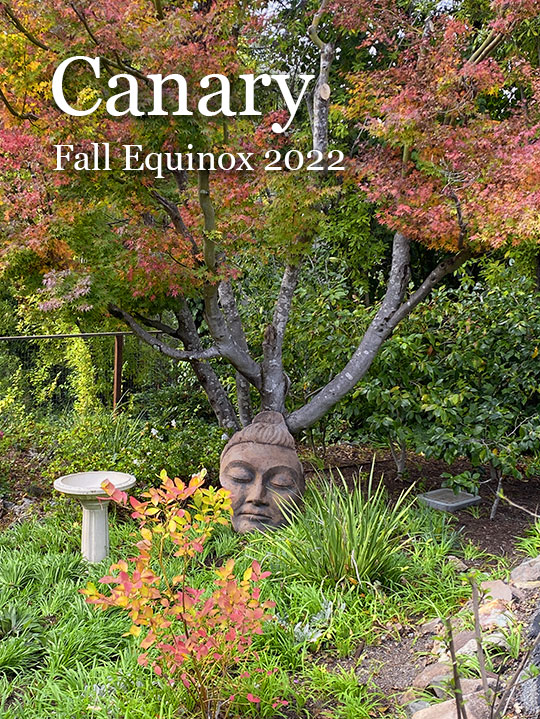
Contents
- Autumnal Equinox, Twenty-Twenty by Sharon Tracey
- Me and Prairie Dropseed by Sharon Tracey
- Slaughter by Faith Van De Putte
- Late Dusk Forward by Richard Lyons
- Snowfort Theory by Janine DeBaise
- For the Vultures by Anne Evans
- The Horses on Meadowbrook Road by Anne Evans
- What Water Does by Grace Marie Grafton
- Mouse Log by Brett Warren
- Church by Brett Warren
- Precarious by Samantha Smith
- Wounded by Cathy Hird
- White Oaks by Luke Wallin
- Antipodes by Bryanna Plog
- Zero Percent Containment by Caitlin Dunn
- On Trout by Nat Bottigheimer
- Touchstone by D. James Smith
Archives: by Issue | by Author Name

Autumnal Equinox, Twenty-Twenty
by Sharon Tracey
Sharon lives at the edge of field and conservation land in the Connecticut River watershed in Western Massachusetts. The Connecticut is the region’s longest river, flowing through five states, from the Canadian border to Long Island Sound.
The sun slipped under houses, one moment light, then a finger’s small poke on the
horizon to start again the dark.
Animals understood except for us who stayed inside, somehow far less equipped.
We brace ourselves— for days of shorter straws, a maw that won’t be sated until
the last drop is squeezed and doled out.
Which should be no surprise but we forget. This is the world.
Gather up the children.
Be alert past twilight.
See that the deer have bedded down. This is the world.
A half-cup of light, half-cup of dark.

© Sharon Tracey

Me and Prairie Dropseed
—As for man, his days are as grass
Psalm 103:15
by Sharon Tracey
Sharon lives at the edge of field and conservation land in the Connecticut River watershed in Western Massachusetts. The Connecticut is the region’s longest river, flowing through five states, from the Canadian border to Long Island Sound.
I have fallen for the ones spilling forth in fountains
of stems and flowered panicles, June’s green now October’s copper
and I’m lying here with them at eye-level—looking through—
bronze to sky blue— and close-up,
the only way to see everything, quivering and falling
as the chickadees in black caps come to snack and keep good company.
I do believe in beginnings and endings, and yet
I can never accept November
as the last ones
are eaten or buried and the world keeps churning
cruelty and beauty in equal measure,
and we keep hoping for
more of the latter, even the smallest seed.

© Sharon Tracey

Slaughter
by Faith Van De Putte
Faith tends pasture, gardens, marsh, and second growth Douglas fir forest on Midnight’s Farm smack dab in the middle of Lopez island in the San Juan archipelago surrounded by the currents of the Salish Sea.

After cleaning up,
when I was coming in to make dinner,
the flock of mallards on the marsh
rose together, arching across the sunset,
only to land again
with much scolding and worry.
Overhead an eagle,
with talons lowered,
swooped down
graceful, silent, and intent.
It is so easy to identify with the ducks,
fleeing the predator
but I know that today
I am more aligned with eagle.
There is blood on the driveway,
in the grass, on my pants and hands.
We fed the seven pigs their last breakfast
and then ushered them one by one into the chute.
It is fast,
how life ends.
I held a tub under each neck
and caught the last heartbeats of blood.
Startlingly red.
© Faith Van De Putte

Late Dusk Forward
by Richard Lyons
Richard lives one hundred yards from the Wolf River Watershed, where the Wolf River Conservancy meets Walnut Grove Lake--some twenty miles east of the Mississippi River.

The cellar holes heal like wounds.
Who exactly kicks the door ajar?
The pileated woodpecker’s hole
now belongs to saw-whet owls. A snake
is immobilized by the weight of its kill.
The mice reproduce so fast the number
of pine martens increases incrementally.
Hope the temperature doesn’t drop too low,
especially for us unable to enter diapause.
I’d hate to die of overexposure,
not quick enough to live in the unfazed wild,
frost stippling my eyelashes just as the sun rises.
© Richard Lyons
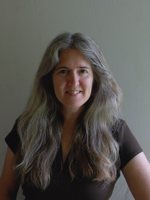
Snowfort Theory
by Janine DeBaise
Janine lives in a wooded, swampy area a few miles south of Oneida Lake on land that is the ancestral home of the Haudenosaunee Confederacy. Since childhood, she has spent summer weekends on a rocky peninsula of oak trees in a marsh on the Saint Lawrence River, where she sails with her father.
A new sign tacked to the lone tree said: No Trespassing.
My father and I, in his eighteen-foot sailboat, had just glided closer to the island to read the bold black letters. We were in the Thousand Islands region of the Saint Lawerence River, and we knew this particular island well. We’d come to it many times on a sunny afternoon, the rest of the family in tow, to swim off the rocks and sunbathe on the ledge. But now it would now be off limits.
“New owner,” my father said with a sigh.
I nodded. We knew the pattern.
The first thing someone does after buying an island is to put up No Trespassing signs. That seems to be the crux of private ownership of land: you get the right to keep people off. And then you start building.
A few weeks later, we saw a barge pulled up to the island, filled with cinderblocks and lumber. Each time we sailed past, we could hear the furious activity of hammers, drills, and circular saws. Gradually, the structure took shape. By the end of the summer, the island sported a new cottage, complete with fancy deck, sturdy dock, and Adirondack chairs.
The second summer, we saw people enjoying the new place: kids playing in the water, a woman in a chair reading a book, and a man sunning himself on the dock. But by the third or fourth season, the island looked deserted: the house locked tight, the dock empty. The No Trespassing signs faded and fell away, allowing local people to swim or fish there with impunity. We knew if the building stayed abandoned long enough, it would disappear altogether, knocked down by the ice and wind, and the island would become one of the uninhabited islands where families like us go for a swim in the deep river water.
But then come spring, a new No Trespassing sign will go up, and the whole process will begin again. Each time, the place that gets built is a little bigger, a little more ambitious, until you have these ridiculously huge buildings on tiny rocks, porches hanging right over the edge of the island.
It's a peculiar phenomena. It almost seems that the more money people spend on a summer cottage, the less they use it. My father, who has been coming to this river for over 80 years, says that people have less leisure time than they used to, that people who work high pressure corporate jobs have the money to build big summer places, but no time to use them. Many come only once a year, or they move away and stop coming altogether.
I've got another theory. I call it the snow fort theory.
When I was a kid, I loved building snow forts. After a good storm, we could build pretty impressive structures with tunnels, cave-like rooms, castle turrets edged with sharp icicles, maybe a lookout tower. Playing in the fort meant building it, adding rooms, scooping out tunnels. The fun part was building and creating. We never actually use the fort for anything, just kept making it bigger. With each new snow fall, we got greedier, building the fort bigger and higher, until a thaw would humble us by collapsing the whole thing.
Sometimes I wonder if our culture is based on the snow fort mentality. We keep building bigger houses, buying more stuff, adding on rooms, making new shopping malls – bigger, better shopping malls – taller buildings, higher walls, wider highways. We are intent on always growing. Our economy is based on the idea of constant growth, as if our resources were not finite. It's as if we Americans are stuck forever in childhood, always just building and buying new stuff, without any thaw to bring us back to the bare ground.
Up on the river, the islands are quickly filling with big stone piers, huge boathouse, and mansion-like summer cottages. But when my father and I sail past in the early morning, the only life we see are the pair of loons who swim near the big rocks and the osprey that makes an amazing dive for a fish. The summer mansions, with their turrets and windows and rows of wooden chairs, remain empty.

© Janine DeBaise

For the Vultures
by Anne Evans
Anne lives in the South Platte River Valley at 5,351 feet near the Rocky Mountain Foothills. The South Platte was originally called Niinéniiniicíihéhe by the native Arapaho people who lived on its banks. Along its banks she encounters myriad waterfowl, birds of prey, and native species including a family of playful muskrats and a few lone herons.

They are the first to spy it,
draped like a woven necklace on the fence,
its vectors glinting gold and copper in the sun:
a geometry of muscle, might of scales,
laid out in a wake of glory.
Its purloined rattle tucked in farmer’s pocket,
a trophy for a child.
Above in an avalanche of circles -
the venue spirals down, slicing
the blue with black wings,
in a narrowing gyre. They light
the fence as a murder of crows,
caws from the corn.
Beaking their way through snakeskin,
scalpel precise, they shred the
sinewy meat. Archaic beauty, their
clean red faces flash against black plume,
bald design for this sacred duty;
nothing is wasted, a merited feast.
© Anne Evans

The Horses on Meadowbrook Road
by Anne Evans
Anne lives in the South Platte River Valley at 5,351 feet near the Rocky Mountain Foothills. The South Platte was originally called Niinéniiniicíihéhe by the native Arapaho people who lived on its banks. Along its banks she encounters myriad waterfowl, birds of prey, and native species including a family of playful muskrats and a few lone herons.

The horses lived in a field surrounded
by a small city growing north and east.
As the city swelled you would think the field
would wane, but instead, it waxed like
a wide, flat moon, and the horses grazed
content in knowing their fences.
As a child, I knew the destinations
(piano lessons, swimming pool, but not
church or school) that shuttled us past
that wink of wild: those soft muzzles and
swishing manes, the whisk of a tail,
the painted pony, the palomino gold.
And so I waited, impatient for Tuesdays, when
we drove by the brief break in concrete
and brick, and the vast grass bloomed
against sky and wind, and the horses might
be standing in the left corner flicking their ears
or grazing midfield munching clover or
trotting or dozing or nuzzling each other
or arching their gentle necks over the fence
near the road so that our wide eyes could
meet through forelock and window with wonder.
© Anne Evans
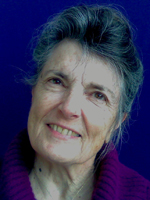
What Water Does
by Grace Marie Grafton
Grace lives in the wooded hills of Oakland, California, in the Sausal Creek watershed. Outside her kitchen door is a second growth redwood tree, part of a landscape that was blanketed with old-growth redwoods at the time of the California gold rush, and a short walk east from her house is the wilderness area of Redwood Regional Park, where she loves to hike.

It's water down there past the trees' morning forum.
Branches mean a lot to him, they wouldn't be here
without water, pictures of leaves the colors
of rust, lichen animating stone but what
means most to him are the crisp flowers
blooming out of cracks in the stolid rock.
To coin a phrase: things change. This white,
this charcoal gray, the remnant of seed
earnest about not letting go. He's decided
not to let go, though he feels suspicious of
his impulse to volunteer at the local soup-kitchen,
maybe he'd be doing it out of schaden freude
and he really doesn't believe he thinks he's
better than they are. Or that he would derive
a frisson of self-worth by placing himself
adjacent to another's slump. Seems to him
to be a matter of luck but also maybe
a matter of noticing the branches, maybe
in a way a squirrel might notice branches,
or the branches might notice the creek just
right there, maybe it's about a pulse of joy
even the rock feels when the seed lands
in the crack, 'a change' Rock says,
'finally, a change.'
© Grace Marie Grafton
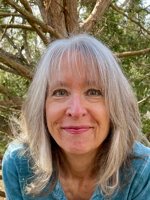
Mouse Log
by Brett Warren
Brett lives on a sandy peninsula in the Outer Lands archipelagic region of the Atlantic Ocean, where she walks in the forests and edge habitats of the Wequaquet Lake watershed. Her house is surrounded by pitch pine and black oak trees—favored nighttime roosts of wild turkeys, who sometimes use the roof of her writing attic as a runway.

Scavenging firewood between storms, we find a pile
of unsplit oak the town left behind. The chipper
will be here tomorrow. I use my foot to push aside
a log almost too rotted to take, but roll it down a slope
toward our truck anyway, until I see a white-footed mouse
tucked into one of its grooves, black eyes all pupil
as she tries to decide whether to jump or stay.
She backs in further, out of sight. So we lift this trunk
like a treasure, nestle it like fine sculpture in a corner
of the truck bed. At home, we unload the mouse log,
carry it like medics bearing a stretcher, set it down
between two arbor vitae, a name that means tree of life,
a kind of tree we have in our yard, but also a structure
we carry in our cerebellum, a word that means little brain.
We have mice in our walls. No one can tell us
how to get them out alive before closing up the holes.
When I can’t sleep, I think of the mouse in her wooden burrow,
the arbor vitae deep within her cerebellum. When she dies,
I hope she falls to weather, to age, to tooth or claw.
Not poison, not a trap, not the chipper’s screaming maw.
© Brett Warren

Church
by Brett Warren
Brett lives on a sandy peninsula in the Outer Lands archipelagic region of the Atlantic Ocean, where she walks in the forests and edge habitats of the Wequaquet Lake watershed. Her house is surrounded by pitch pine and black oak trees—favored nighttime roosts of wild turkeys, who sometimes use the roof of her writing attic as a runway.

The church burned down long before our time.
There’s a boulder where it stood. You can sit there,
if you want, be consoled by leaning stones
of ancestors, their troubles over, or wait
for skunks to come out and forage for grubs
at dusk. Once I saw a woman lying on her back
in the afternoon grass, sobbing. This morning
we walk the cemetery road, two rutted tracks
of sand and shells of broken clams. We stop
to admire an impressive pile of scat—
its grainy texture, its russet color. The scat says
coyote, here, first light. You wonder aloud
about the embedded kernels, pale as hazelnuts
or small planets. I guess acorns, shrug, say omnivores.
We always love to hear the coyotes at night.
To be awakened. You say, I’m glad they’re here
where they can’t be shot. You mean the cemetery—
haven for the dead, the broken open, the alive alive.
© Brett Warren

Precarious
by Samantha Smith
Samantha grew up in the foothills of the Sierra near the Yuba River. Her current home in Colorado sits in a place of transitions where the vast plains to the East begin their dramatic rise into the Rockies and Clear Creek mellows from steep and wild to slow and meandering as it slowly cedes itself into a maze of irrigation ditches

On the day that Tahoe almost burned down, the sky here was hazy, dull, and lifeless. Monotonous grey suffocated the mountains so cruelly that even that eerie fire-season sun failed to make an appearance. On that day, I hadn’t planned to do much outside so I couldn’t complain about my ruined hiking or biking plans, and I felt lucky in a sense. I was far from tragedy without a home, or worse, a family under threat. And yet I couldn’t escape the heaviness.
That day was a hot one here in Golden, a small town on the west side of Denver and my adopted home of the past six years. We decided to settle here, mostly on a whim, after driving through a grand total of one time and deciding that it “felt right.” A little downtown surrounded by mountains, a river running through, proximity to the offerings of a larger city – what more could a semi-outdoorsy, semi-professional couple want?
And the town has not disappointed. It’s a place where work and stress are balanced by easy escapes into the mountains. Families meet up for playdates and coffee at the shaded park by the river. On warm weekends, you can watch your toddler gleefully zip around the pump track on a balance bike and then walk down the hill to the brewery (the one at the edge of town with the views and dog park, not the one near downtown where you always feel too old).
It’s undeniably a great place to live and I’m happy here. But it’s not home. Home is and always has been the Sierra Nevada. In the Sierra, thick layers of pine needles bake in the sun and release a perfect scent that summons both long summer days of free exploration and the impending constriction of fall. Wet oak leaves blanket the ground in winter, to eventually be pounded to a moist, nutrient-rich mush by the rains. Huge slabs of granite are carved smooth on the banks of rivers, creating perfect resting places of warmth – mini ovens to warm bodies chilled from swimming. There is nothing so smooth in the whole world as the skin of a madrone tree. Calling it bark almost feels disrespectful, but the playful curls, peeled away from the tree, simply crunch on the ground as you walk by. They don’t mind.
When the Caldor Fire encroached on South Lake Tahoe last summer, it seemed that it might be successful in destroying the crown jewel of resort towns in the Sierra. As many residents expressed shock – we never thought this would happen to Tahoe they kept saying – I sat in safety in Colorado, surrounded by orange haze and rising panic. Panic and confusion. Why was I so worried about Tahoe? I knew it as a beautiful resort town where I had played a few games of beach volleyball, skied a handful of times, and hung out off and on with an ex-boyfriend, but that was where the memories ended. It certainly wasn’t home.
That night, though, when the fire came dangerously close to breeching the lines and engulfing the town, I checked and re-checked the news, compulsively watched the fire trackers, as if my own home were directly in the path of this unstoppable wall of heat and fury. It wasn’t until I’d spent hours poring over news articles, google-mapping Tahoe National Forest, and generally fretting, that the truth beneath my unease finally emerged: if Tahoe went, anything could go. If Tahoe couldn’t be saved, with its multi-million-dollar vacation homes, fancy restaurants, ski resorts and golf courses, then the humble backwoods of my childhood were all but gone as well.
Out there. In my familiar corner of the Sierra, hippies and rednecks cross paths on dusty backroads and at hidden emerald pools of the Yuba River. The summer sky turns purple at dusk just as the air starts to cool. Blackberry brambles – their jealous spikes guarding a bounty of sun-warmed, juicy prizes – overtake clearings one season at a time, choking out all evidence of emptiness.
In my memory there is a meadow filled with tall yellow grasses, where seed pods glow in the morning sun as I make my way along the dirt path to school. In winter, ice crystals push up from the soil in the middle of the path, creating temporary crystal palaces that will soon melt back into mud. Odes to the brilliance and impermanence of nature. A field of scotch broom sits out back behind the old cabin, army green and cheerfully yellow in the spring. And of course, The Big Cedar Tree that welcomes me with open arms as I learn to climb.
When I was young, the 49er Fire blazed through the local mountains and canyons. My memories are few: hushed conversations, snippets of discussion at the gas station about evacuations, and the family that parked their RV in our driveway after their house had burned down. As a child I couldn’t understand the danger to human life or the impact on the land, but that fire became the Goliath of all fires to me. It was, I was sure, the fire to which all other fires in the future would be compared.
To the credit of my seven-year-old self, I pretty much got it right at the time. In 1988 the 49er Fire was recorded as the third most destructive in state history, burning slightly more than 30,000 acres. Yet a changing climate would ultimately prove me wrong. A little over a quarter-century later, that fire that traumatized the community and land that I called home doesn’t even make it onto the top 20 list anymore. In tragic contrast, the Dixie Fire last summer burned 963,309 acres, and California’s largest fire to date, the August Complex fire of 2020, burned more than a million acres.
The Caldor Fire (which burned a mere 221,835 acres) did not take out South Lake Tahoe that night after all, thanks to heroic firefighting and some lucky weather breaks. But that night my eyes were forced open to a reality that I had willfully ignored for so long: those wild and tender places that created me, so un-grand in comparison, were not even close to safe. After all, who would spend hundreds of millions of dollars to protect a perfect meadow, or a patch of weedy scotch broom, or even a tree so memorable that it stays with a little girl for a lifetime?
One day after I’d finished college my mom asked a question that she’d probably pondered for a while. “You probably won’t ever move back, will you?” Her voice caught as she said the words, like she was just having the realization that I was gone forever.
I’d grown up cradled by the mountains and forests, but with age I became restless and desperate to escape the imperfections of my small world. As soon as I could, I ran to the city where I discovered manicured lawns, tended hedges, flower beds managed with mowers and fertilizers, and a starless sky that glowed orange and purple. I also discovered excitement and opportunity and thought of moving back home, even to my beloved Sierra, was nowhere on my radar.
My answer came out too quickly, but I wasn’t surprised by it. “Uh no mom, I don’t think so,” I muttered eloquently. Didn’t she know? When I had left, I had left for good.
Now though, an adult woman with children of my own, I treasure that deep belonging and intimacy of place that I was so freely granted. The possibility of return comforts me, and the calming knowledge that I could be there again, anytime, is a balm to the anxieties of everyday life. With just a quick and simple plane flight, I could once again stand on that steady and solid ground, relinquish the bad and the good and the mundane of the years, let it seep from my bones back into earth that knows me so well.
Or so I have always thought.
*
It’s winter now, here in the Rockies. Snow covers the barren ground in a cold and serene blanket of protection. The fire next to me glows soft and warm, friendly. I relax into its cozy presence, but as it pops and hisses inside its iron cage, I am reminded of the inevitable: soon, spring will come to California, and then summer. That foreboding loss and longing that seeded itself in my chest last summer begins to reawaken.
Here, a thousand miles from home, I am overpowered by the scent of pine needles baking in the afternoon sun, the taste of dust-covered blackberries, and visions of glowing grasses in an oak-lined meadow where a young girl skips, carefree, towards home.
© Samantha Smith
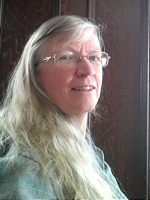
Wounded
by Cathy Hird
For over thirty years, Cathy ran a family sheep farm on the edge of the spine of limestone known as the Niagara Escarpment. In 2018, she moved a little north and now lives sheltered under the same escarpment on the fresh water inland sea known as Waaseyaagami-wiikwed by the Ojibwe, the traditional keepers of this land.

I saw the bark before I saw the wound
black strip curled on the grass
tempting my dog to chew and rip.
Looking up I cringed for you
sickly grey wood where your skin should be.
You survived the clearing of this space
young tree left standing to shade the grass
an act of gratitude for tart fruit offered
to those who reach and pick
and those who graze the fallen.
Something injured you, carved this laceration
machine or hungry porcupine, disease perhaps,
explains how few apples formed this year
upon your branches.
How much longer can you stand,
wounded, suffering
so little left to offer but your wood.
© Cathy Hird
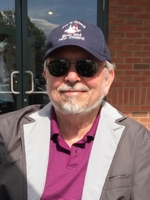
White Oaks
by Luke Wallin
Luke lives in the Sakonnet River watershed basin near the Atlantic Ocean on a stream that flows north.
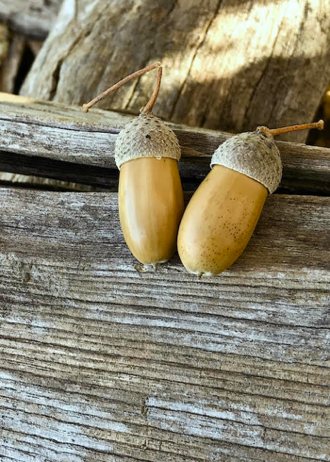
Beloved of deer in the frost,
sweet with only a trace of tannin,
long elegant White Oak acorns
lay upon the damp-leaf trail.
Before a squirrel could make his play,
a boy stopped and picked them up.
That night he slept with fingers pressing,
working them in his palm, dreaming.
He saw flooding across the woods,
acres of white beaver sticks floating there,
rafts of acorns trapped in brown water,
catfish having escaped the river
taking those acorns with pops of air, then
flights of Wood Ducks swooping down
claiming the beauties for themselves,
until a bear came splashing through.
The river would plant them as it could,
the trees would slowly claim sunlight
and outcompete the weaker tribes,
until the boy grew old enough to
make a decision, whether he would
be the one to hold an auction,
and if so whether to cut them all,
or spare the ones of a certain diameter.
In that case how many more years
would pass before his forest would rise
once more grand? He would judge his own son’s
hope, to keep the cathedral wild.
If he waited long enough, tornadoes
would come and tear things down.
His son would hunt in the splintered stumps,
in milkweed and honeysuckle weave,
with memories of his younger years, and
those passed down from the old man’s time.
What if the father gave up killing, what if
the son moved away to a city?
What if a young man bought the whole place,
and planted fields, and raised shooting houses,
and laid down rules of who could shoot, and who
could be shot, so that the bucks grew antlers not seen
before, but the bucks went tame, and the hunters, too,
and it fell to the river to spread White Oaks, as it could?
© Luke Wallin

Antipodes
by Bryanna Plog
Bryanna lives in the Cascade Mountains, where the waters from glaciers and snowmelt travel east into the Columbia River before they journey west to the Pacific Ocean. Her home is along the shore of Lake Chelan, the "deep water" to Salish-speaking people for generations.

I first remember reading the word “antipode” as I sat in a train click-clacking through the frozen plains of central Montana. Back then, a coach ticket on Amtrak’s Empire Builder came with an in-seat magazine that included bits of information about each town that the train stopped in. And there it was: "Shelby, Montana is one of only three locations in the U.S. which have antipode (land directly opposite them on the other side of the planet). Traveling from Shelby through the center of the earth, one would arrive in the Kerguelen Islands, a scientific outpost."
Weathered barns and beaten roads passed by my train window as we picked up speed to venture further east into the vast grasslands of Montana. Sitting there in my seat, watching fields of shorn hay sticking up among puddles that had become solid in the frigid December air, I thought about the other side of the world.
We sometimes say “the other side of the world” as some sort of vague dismissal—people, lands, and waters so distant from us that they don’t deserve any distinguishing feature. They are simply opposite. Out of sight. But for a few moments as my train sped up and left Shelby, Montana, there was not simply an unnamed stretch of ocean on the other side of the world from me, but mountains, and outposts of people.
As is well known, it’s not likely that if you start digging a hole in your childhood sandbox you’ll end up in China. For me, growing up north of Seattle, if I survived the superheated mantle and core of our planet, I would have ended up in the southern Indian Ocean, not quite halfway between southern Africa and Australia. With 70% of our planet covered by oceans, you have to choose carefully if you want to tunnel through the planet and end up on land on the other side.
There are cities and forests and plains with antipodes that correspond with other lands, of course. Whangarei, New Zealand, meet Tangier, Morocco. Hong Kong: La Quiaca, Argentina. Lima, Peru and Pursat, Cambodia. Tahiti and northern Sudan. The central Andes of Colombia and southern Sumatra, Indonesia. One of the most intriguing pairings is that Taiwan, formally known as the island of Formosa, is antipode with the province of Formosa in Argentina. Both words relate to the Latin roots of “beautiful” in Portuguese and Spanish respectively.
What if the other side of the world was not the foil of the hero of a Shakespearean tragedy, but more like two characters in a romantic comedy who are inexplicably linked? Opposites can attract. Two opposites can make something whole. If our world really is a sphere hurdling through space, we’ve all got an antipode we rely on on the other side of the world. The idea of “polar opposites,” emerged in the early 1800’s when we realized there were opposite yet similar frozen worlds at either end of our round planet.
If you are one of the billions of people whose antipode is in the ocean, does that not invite you to take a deeper look at that part of our planet, where basins and mountain ranges are as full of incredible life as our terrestrial neighbors? That random latitude and longitude is not just the middle of nowhere. It’s your antipode—your match. (And if you want to end up in China, start digging that hole in central Chile or northwestern Argentina.)
The Hawaiian Islands are your best bet to find land opposite of the United States: their antipodes are the dusty deserts of northern of Botswana with the western coast of the Big Island lining up with the edge of the lush Okavango Delta. Dig down through the permafrost of the northern edge of Alaska and you’ll be somewhere along the Princess Ragnhild Coast of Antarctica. Besides western Montana, the only other place in the contiguous United States with land antipodes are parts of southeastern Colorado which correspond with two other islands in the Indian Ocean, Saint Paul and Amsterdam.
Saint Paul, Amsterdam, and the other Kerguelen Islands are all sub-Antarctic islands, where ships pass but no humans originally called home. They are now administered by France. I learn that over time, whalers, settlers, and scientists in the Kerguelen Islands have brought the modern world to what are now remote outposts. The islands are populated with invasive species, from rats to rabbits to cats. The warming climate is melting its glaciers. Montana and the Kerguelen Islands have that in common.
December in the Kerguelen Islands is the end of winter, with the sounds of squawking from king penguins and gulls filling the air and green grass growing below rugged hills. I imagined a stiff, biting wind in the Kerguelen Islands not unlike the gusts swirling outside my train window in a Montana winter. There would be mountains jutting up from flat horizons in the Kerguelen Islands just like in Shelby—in one place the never-ending flatness of the Great Plains, the other the Indian Ocean stretching out as far as the eye could see.
Antipodes are not simply opposites. Translated from the Greek, anti-pode means “men that have their feet against our feet” or “with feet opposite ours.”
There is a relationship with the other side of the world.
© Bryanna Plog

Zero Percent Containment
by Caitlin Dunn
Caitlin grew up just above a floodplain in the San Luis Valley with the Huerfano River to the north of her home. She currently lives in the Big Dry Creek watershed and struggles to grow plants outside in her 6a growth zone garden.

At seven, the raw
water cuts out. In the hills
before the sunset
we see where it went.
Fire in rebuking fingers
over Trinchera
Mountain and the Pass.
They say the sound of it is
like a coal train, or
a heavy North Wind,
but from the valley we just
hear helicopters
and ringneck doves. It
hasn’t rained in months. Six hours
ago a man down
the way thought he’d strike
up a campfire to cook some
Jimmy Deans. The world
takes videos of
his last mistake while it crawls
like hate toward us.
© Caitlin Dunn
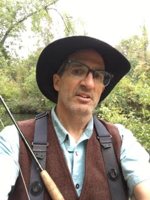
On Trout
by Nat Bottigheimer
Nat lives up the hill from Harry’s Brook, a tributary of the Millstone River in the New Jersey Piedmont. He grew up on the north slope of a glacial moraine. Saltwater creeks are his favorite waterbody.
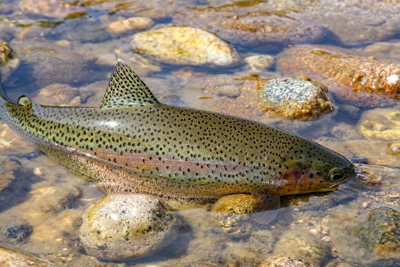
A trout prefers
The easy flow
A back eddy’s seam
Or the lee of a rock,
And where conjoined currents
Concentrate the uprising
Emergers or downfallen
Spinners, hapless
Ants or nymphs that have lost
Their grip on the stream bottom.
There they scan up and out at
The foam buffet, or
Fin in place mouthing
Each mote of the stream’s
Tumbling litter to discern treasure
From trash. Knowing
Where they like to lie
Alters not at all
The enigma that creatures
Bedecked in water-lily pinks and
Seurat stippling,
Birth of Venus blossoming or
A Chagall coral orange
Can be right there yet
Unseen in the dappled
Limpidity. If you have
The grace to cradle
One of these in your cold,
Wet hands you
Will feel an urgency old
As creation not to escape
But to return, to a place
Invisible yet in the midst
Of everything, a power
Of current made flesh.
Don’t see me, a habit
Constant as breath.
© Nat Bottigheimer
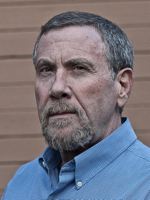
Touchstone
by D. James Smith
Smith lives in the irrigated, semi-arid desert plain of California's central valley, spending a great deal of time in the nearby foothills and the Sierra.
Faint waves nose logs stranded along the shore.
I stop and toe the battered lips of a perch.
Wind picks at its translucent fins, the sky, close
with the tattered black of a coming front.
Off a small bluff a sandhill crane catapults, lifts
and swings around and works its way
along the ridge where maples flame and digger pines
stretch wide their rusted arms.
I come again to this boyhood place as the season
starts its great change, the hills
deepening with bloodied patience.
I don’t know what to ask. Another year
of the dark water that fills my sleep?
A dog barks somewhere in the trees, faint, persistent.
The lake twitches like a face as a frog
flays the surface, rippling out, phosphorescent.
And I think I am not my only father and mother
as I go each day from breath to breath
in need of a place like this, the charcoal
reeds, tipped with red, the light that fails softly
over a cove, these tribes of insects beginning to sing.

Previously published by Stephen F. Austin University Press
© D. James Smith